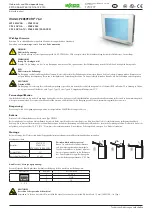
8. Troubleshooting
If the expected performance is unachievable after installation of the air trap, read chapter 4.
"Proper Installation" and chapter 5. "Piping Arrangement" again and check the following points
to take appropriate corrective measures.
Problem
Cause
Remedy
Float is damaged or filled with condensate
Orifice, screen or piping is clogged with
rust, scale or dirt
The trap operating pressure exceeds the
maximum specified pressure, or there is
insufficient differential pressure between
the trap inlet and outlet
Air binding occurs
Orifice is clogged or rust and scale have
accumulated under the float
Orifice is damaged
Float is deformed or coated with scale
Trap is installed above the maximum
allowable inclination angle
Vibration of trap occurs
There is no condensate in the air trap
body, no water seal around the valve seat
Deterioration of or damage to gaskets
Improper tightening torque for cover was
used
Water hammer occurs
No condensate is
discharged
(blocked) or
discharge is poor
Air is discharged
or leaks from the
trap outlet
(blowing)
(air leakage)
Air leaks from a
place other
than the trap
outlet
Float is frequently
damaged
Replace the float
Clean
Compare specifications and
actual operating conditions
Check and correct balance
pipe and inlet pipe arrange-
ment
Clean
Replace the orifice
Clean or replace the float
Correct the installation
Lengthen inlet piping, then
fasten it securely
Prime the air trap with water
Replace the gaskets
Tighten to the proper torque
Examine the piping for
problems that can cause
water hammer and repair






























